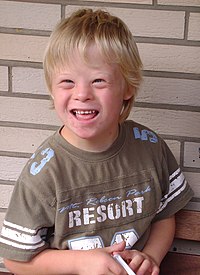
Photo from wikipedia
Introduction Wolf-Hirschhorn syndrome is a rare condition including a characteristic facial appearance, delayed growth and development, hypotonia, intellectual disability and seizures. Its frequency is estimated at 1/20000 to 1/50000 births… Click to show full abstract
Introduction Wolf-Hirschhorn syndrome is a rare condition including a characteristic facial appearance, delayed growth and development, hypotonia, intellectual disability and seizures. Its frequency is estimated at 1/20000 to 1/50000 births with a female predilection. It’s due to a genetic material deletion near the short arm of chromosome 4 (4p-). Through this case report we aim to remind the mains and associated features of this rare disorder as well as its management. Methods We report the case of male newborn with a Wolf-Hirschhorn syndrome. Results A full term newborn was born by c-section indicated for a severe growth restriction. Birth weight was 1850 g, length was 45 cm and head circumference was 30,5 cm. Clinical examination at birth noted an important hypotonia, cyanosis with no associated signs of respiratory distress, distinctive facial features including a broad and flat nasal bridge, a high forehead, widely spaced eyes with iridian coloboma, poorly provided eyebrows, poorly formed ears with a pre-tragic fistula, micrognathia, thin lips and posterior cleft palate associated to a spina bifida occulta, posterior hypospadias, testicular ectopia and mottled skin. Echocardiography showed a type A interruption of the aortic arch. The ultrasound examination of brain and abdomen was normal. The genetic tests concluded to a wolf-Hirschhorn syndrome with a (4p) deletion. The boy died at the age of one month due to a severe bronchiolitis. Parental genetic tests are planned. Conclusion Wolf-Hirschhorn is a rare genetic disorder. It may be inherited but generally it occurs as a random event. Its outcome depends on associated malformations especially congenital heart disease. We insist on the importance of genetic counseling and antenatal diagnosis when index cases are registered.
Journal Title: Archives of Disease in Childhood
Year Published: 2019
Link to full text (if available)
Share on Social Media: Sign Up to like & get
recommendations!